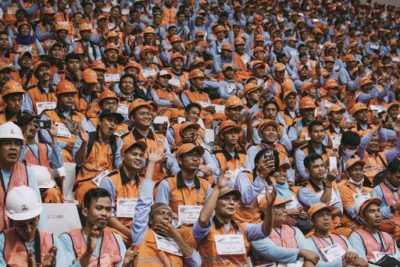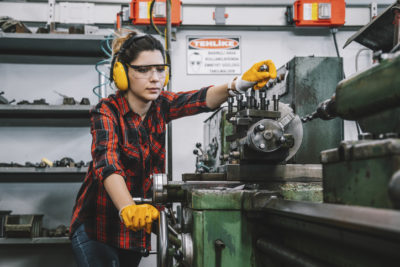
Blue-collar workers are the backbone of America. This workforce consists of skilled individuals who work primarily with their hands. They keep our lights on, buildings standing, and energy flowing. “Blue collar” jobs include manufacturing, custodial duties, and manual labor.
Companies are now aware of the benefits that rewarding employees can bring. Offering incentives will boost morale, performance, and retention.
That said, blue-collar worker rewards should reflect the nature of their job. Unlike inside of an office, introducing a ping-pong table or work-from-home benefits just don’t apply here. If you want to reward these employees, read on to identify which ways will most engage them, and show that they’re valued.
Blue Collar vs. White Collar
The terms “Blue Collar” and “White Collar” were coined in the 1920s. At this time, trade workers wore hearty denim shirts that contrasted the pressed white ones worn by office employees.
 Throughout the 20th century, trade-unions challenged management in the struggle for workers’ rights. By the 1980s, blue-collar workers became even more pressed. As labor costs increased, companies exported manufacturing jobs overseas.
Throughout the 20th century, trade-unions challenged management in the struggle for workers’ rights. By the 1980s, blue-collar workers became even more pressed. As labor costs increased, companies exported manufacturing jobs overseas.
For decades, the shifting global economy led to a cultural rejection of these jobs. Young Americans saw these roles as obsolete and flocked to office jobs. Today, the switch has flipped. The tech revolution has created a massive demand for well-paid, highly skilled blue-collar workers.
Companies now see the benefits of rewarding blue-collar employees. They’re designing programs as they would do in the past within an office with accountants, administrators, management, and the like.
1. Career Development Opportunities
American society has, unfortunately, considered blue-collar work inferior to white-collar roles. Since the latter requires a higher level of education, it’s assumed that these individuals are more educated. In reality, this assumption is untrue and many blue collar workers are focused on career advancement.
 Management and human resources departments have the responsibility to remove the stigma against manual labor. It starts with having an open-minded outlook on defining intelligence and aspiration.
Management and human resources departments have the responsibility to remove the stigma against manual labor. It starts with having an open-minded outlook on defining intelligence and aspiration.
In Germany, for example, working in the skilled trades is a highly suggested career path. German companies encourage students to take up these jobs. They even offer apprenticeships to young people and partnering with trade schools.
An Opportunity for Growth
Encouraging employees to climb the ranks is a smart decision for management. Recognize blue-collar workers by offering the opportunity for promotion to decision making roles. All too often, we see a disconnect between decisions made and the work done in the field. It’s beneficial to have diverse leadership.
Businesses can bridge the gap and boost morale by integrating blue-collar and white-collar employees. Growth incentives are especially important if you’re looking to recruit young people.
Millennials and Gen Z will be more attracted to a role if they know that they have the opportunity to evolve and gain more responsibility. Without this potential for growth, they’re more likely to turn down or quit an unsatisfactory job.
2. Monetary Rewards
The most straightforward demonstration of appreciation comes in the form of financial rewards. These incentives can be performance-based bonuses, raises, or formal rewards programs. Money is a great way to show that you recognize the value of the individual who’s responsible for the hands-on tasks of your company, especially when they do it well.
 Example: W.L. Gore
Example: W.L. Gore
Monetary incentives motivate workers, and they can come in many forms. Some companies offer employee stock options and profit-sharing plans. One example is W.L. Gore, the maker of Gore-Tex. This company has long been revered for its management as Gore created an innovative management model that bound together an organization and its workers.
Bill Gore, the company’s founder, built W.L. Gore on two core principles:
- Belief in the individual
- Freedom
These values are visible in the way W.L. Gore rewards workers. They tout an Employee Stock Ownership Plan (ESOP) where employees share in the risks and rewards of the company. This gives all workers the incentive to stay committed to long term success.
3. Tangible Rewards
Since blue-collar employees work with their hands, they typically prefer tangible rewards over anything else. These gifts include personalized gear, gift baskets, or new workman’s boots.
 In a study conducted by Incentive Concepts, researchers asked employees what type of rewards they preferred. 62% of respondents said that they liked tangible gifts more than personal recognition, public praise, and professional development opportunities.
In a study conducted by Incentive Concepts, researchers asked employees what type of rewards they preferred. 62% of respondents said that they liked tangible gifts more than personal recognition, public praise, and professional development opportunities.
4. Experiential Rewards
The millennial workforce is known for its preference for experiential rewards. Blue-collar workers enjoy bonuses that offer them the chance to enjoy a new experience. Some companies provide an opportunity to eat lunch with the CEO. Others even give fully or partially-paid vacations as a prize for top performance.
Small businesses with limited budgets can offer tickets to the next baseball, basketball, football, or hockey game. This will undoubtedly please your workers, as over 60% of Americans say that they’re sports fans.
Experiential rewards can also be paid vacations, sports games, group outings, or even training sessions that focus on career growth. You can provide the opportunity to attend off-site training events. The team members who go will love the fact that they’re getting away from the work site for a day or two, getting attention, and learning the skills they need.
5. Verbal and Peer-to-Peer Recognition
Verbal praise holds a lot of value in terms of employee recognition. Employees will feel reassured when they know their efforts and contribution hasn’t gone unnoticed. It’s vital that your workers feel valued and appreciated.
 It makes sense if we consider Maslow’s Hierarchy of Needs. In this theory, it’s explained that two of the most valuable psychological needs for humans is to have a sense of belonging and to be appreciated. This is why compensation and verbal support are fundamental to the success of any business.
It makes sense if we consider Maslow’s Hierarchy of Needs. In this theory, it’s explained that two of the most valuable psychological needs for humans is to have a sense of belonging and to be appreciated. This is why compensation and verbal support are fundamental to the success of any business.
As the old saying goes, “A bad boss has you coming in feeling like a lion and leaving like a lamb. A good boss has you coming in feeling like a lamb, and leaving like a lion.” Make sure that your blue-collar workforce is getting as much support and praise from higher-ups as their in-office counterparts.
A Powerful Tool
Employee recognition is a highly-effective strategy for enhancing engagement in the workplace. Well-implemented staff appreciation programs are a powerful tool. They can boost all aspects of a business, including morale, productivity, and retention.
According to Bersin & Associates, employee recognition programs can reduce turnover by 31%. For this to be successful, people must be rewarded with specific results and behaviors and represent the company values and goals.
The ROI of Employee Recognition
Most management and HR professionals are aware that rewarding employees for efforts are a nice thing to do, but unfortunately, this can get placed on the back burner when it comes to budgeting.
As a business leader, there’s nothing more important than recognizing the individuals who allow it to succeed. Not only is it the moral choice, but it also will protect your assets and financial concerns. In this section, we’ll go over the real return on investment of blue-collar employee recognition programs.
Drive Better Business Results
In 2007, Delta airlines launched a massive employee recognition program. After one year, the company reported a 546% ROI. Most senior managers understand that these people-oriented initiatives are investments rather than expenses.
 Why is the ROI associated with these programs so high? As we’ve noted throughout this article, people work harder when they’re promised a reward. When blue-collar workers work harder, that means that there will be an increase in production, output, and revenues. This means one thing- happy employees equal higher profits.
Why is the ROI associated with these programs so high? As we’ve noted throughout this article, people work harder when they’re promised a reward. When blue-collar workers work harder, that means that there will be an increase in production, output, and revenues. This means one thing- happy employees equal higher profits.
Improved Quality
While, of course, you want to retain and satisfy the expectations of the worker, you want to make sure that they’re productive and efficient. When your workers know that they are crucial to the operation, they’ll be more committed to producing high-quality results.
Retention
In a world where skilled labor is harder to come by, one of the most important reasons for employee recognition is retention. Many blue-collar jobs require extensive on-site training, which is costly and time-consuming for management. Having high turnover rates means that too much of the company resources will be wasted.
Luckily, most blue-collar workers prioritize job security. As much as they want to stay with you, you want them to stay with you as well. Recognize the successes and listen to the ideas of those who fill these crucial roles. By doing so, you’ll command the respect and loyalty of hardworking men and women who share in your success.
Peer-to-Peer Recognition
It’s essential that workers are appreciated by management, but it’s just as crucial that their peers recognize their successes as well. Since blue-collar workers typically work in teams, their peers know what they do on a daily basis and a simple “thank you” goes further than you would expect.
 The most successful modern high-performance programs are social in nature. These “thank yous” are made public and displayed somewhere that’s visible. When stories of rewards and recognition are spread throughout the workplace, other employees will be motivated to do better as well.
The most successful modern high-performance programs are social in nature. These “thank yous” are made public and displayed somewhere that’s visible. When stories of rewards and recognition are spread throughout the workplace, other employees will be motivated to do better as well.
Today, social employee rewards programs are streamlined and straightforward, thanks to innovative solutions. We recommend leveraging a digital platform that allows employees to send a thank you along with points to each other to redeem on thousands of items and experiences. With the touch of a finger, they can send recognition for hard work, small successes, and significant accomplishments.
Since these points never expire, workers can collect them and continue to strive for more to redeem thousands of items and experiences of their choice.
Platforms like these make it easy for blue-collar and white-collar employees alike to socialize with others. They can easily view, like, and add comments within the global feed, making rewards public and sharing stories of individual success.
6. A Group Outing
Encouraging a positive working environment among blue-collar employees can help raise overall job satisfaction. Many of these workers, like commercial electricians and ironworkers, work in dangerous situations where their safety depends on their peers. It’s essential that teams share a sense of confidence and trust. Collective rewards are especially crucial for these employees.
 If a team is working together well, that should be recognized. Whether it’s a group lunch, a morning pep-talk over coffee and donuts, or a full-paid team retreat to the island of their dreams. These sorts of benefits incentivize collaboration and foster social bonding.
If a team is working together well, that should be recognized. Whether it’s a group lunch, a morning pep-talk over coffee and donuts, or a full-paid team retreat to the island of their dreams. These sorts of benefits incentivize collaboration and foster social bonding.
One way that you can reward blue-collar teams is to listen to any collective grievances that they may have expressed. If your factory floor team has expressed any dissatisfaction with long hours of standing, but you can’t offer more break time, consider buying them all new high-quality shoes designed for their comfort.
When they know that management is listening, employees will feel supported and appreciated. They’ll be especially satisfied if those in charge meet their specific needs.
The Solution
An easy way to please a blue-collar workforce is to listen. Take the necessary steps to understand the needs and demands of the job. When labor costs more, it’s for a good reason. With training, incentives, and high-quality equipment, there will be a boost in productivity and morale. When you take care of your workers, everyone benefits.
The Verdict
Too much of recent history has valued white-collar work over the blue. Laborers are the soul behind every company. Many of them work in factories to keep the office building standing. Employers are starting to consider the value of employee rewards programs for these individuals, and it’s time you pay attention too.
Whether it’s through verbal praise, social gatherings, or a reward, it’s easy to implement rewards. Employees will feel more dignified in their work when they’re acknowledged. It’s important to offer the workforce a feeling of security, growth potential, and appreciation.
Employers looking to attract and retain skilled talent need to focus on these programs. In developing initiatives, it’s essential that companies understand the demands of workers. Rewards boost worker performance and help build a relationship based on confidence, trust, loyalty, and respect.
 Example: W.L. Gore
Example: W.L. Gore